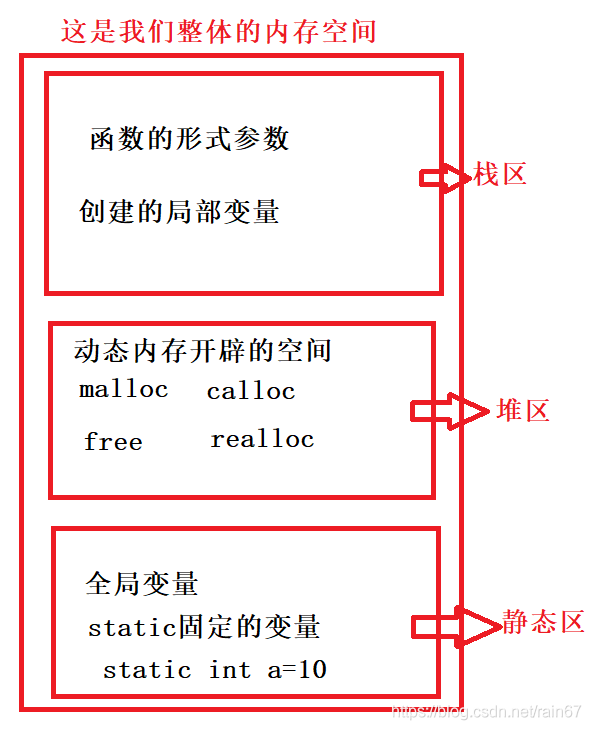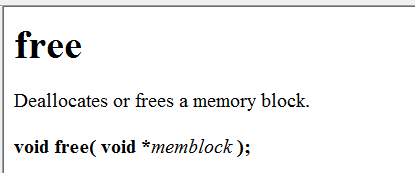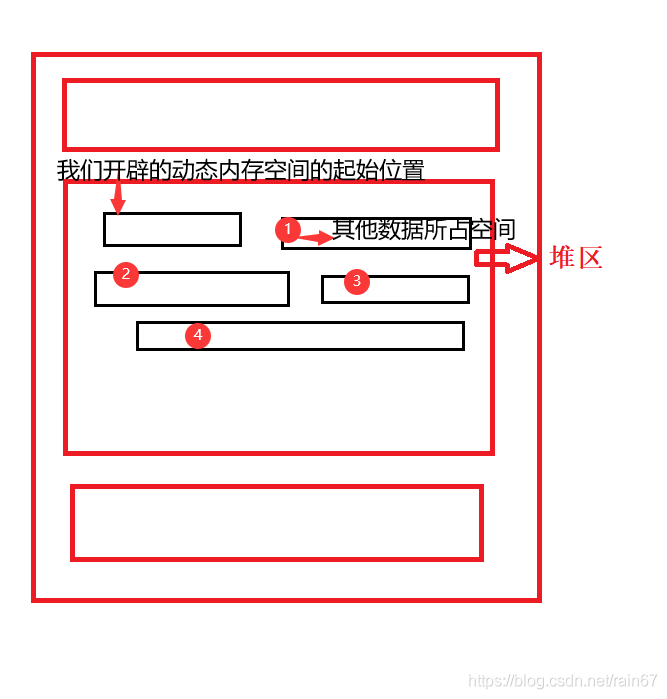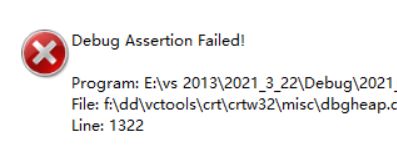C语言进阶(七)——动态内存管理
文章目录
- 动态内存管理
-
- 前言
- 一、为什么存在动态内存分配?
- 二、动态内存函数的介绍
- 1.malloc函数的介绍
- 2.free函数的介绍
- 3.malloc函数和free的配合使用
- 4.calloc函数的介绍
- 5.calloc函数的使用
- 6.realloc 函数的介绍
- 7.realloc函数的使用
- 三、常见的动态内存错误
- 1.对NULL指针的解引用操作
- 2.对动态开辟的内存进行越界访问
- 3.对非动态开辟的内存free
- 4.使用free释放动态内存的一部分
- 5.对同一块动态内存多次释放
- 6.动态开辟内存忘记释放
- 四、动态内存经典笔试题
- 1.练习一
- 2.练习二
- 3.练习三
- 4.练习四
- 五、C/C++程序的内存开辟
- 六、柔性数组
- 1.柔性数组的特点
- 2.柔性数组的使用
- 3.柔性数组的优势
- 完
动态内存管理
前言
当前我们知道我们使用内存的方式
1.创建一个变量
int a=0;
全局变量——在静态区开辟内存
局部变量——在 栈区开辟内存
2.创建一个数组
一个数组是一块连续的内存空间
int arr[10]=0;
创建全局数组——在静态区开辟内存
创建局部数组——在栈区开辟内存
3.函数的形参和实参
还有一些其他的数据占用着内存空间,具体的内存使用情况如下:
一、为什么存在动态内存分配?
我们已经掌握的内存开辟方式有:
int val =20; //在栈空间上开辟4个字节
char arr[10]={0}; //在栈空间上开辟10个字节的连续空间
char arr[20]={0};
这里给了我们一个能够存放20个字节的连续内存空间,那么如果我们有10个char 类型的数据要储存,那么就要浪费剩余的内存空间,如果我们有30个 char 类型的数据要存储,那么arr数组的空间又不够我们存放数据。
但是,对于空间的需求,不仅仅是上述的情况。有时候我们需要的空间大小在程序运行的时候才能知道,那么数组在编译时开辟空间的方式就不能满足了。这个时候,我们只能试试动态内存开辟。
二、动态内存函数的介绍
1.malloc函数的介绍
c语言提供了一个动态内存开辟的函数:

函数的功能: 开辟一个内存块
函数的参数: 开辟空间的字节大小
函数的返回类型: void * 空指针类型
2.free函数的介绍
c语言还提供了另外一个函数free,专门用来做动态内存的释放和回收,函数原型如下。
所以我们要将malloc申请的空间进行释放
free(p);
p=NULL;
因为p被释放掉了,所以p指向的空间没有了意义,但是那块空间的内容还在,所以p还是有能力找到这块空间,为了避免这块空间被错误的使用,我们将p=NULL,赋成空指针,这样就p指针就真正的断开了与这块空间的联系。
3.malloc函数和free的配合使用
注意:malloc 和 free函数都要引用
#include 4.calloc函数的介绍
C语言还提供了一个函数叫 calloc ,calloc 函数也用来动态内存开辟。原型如下:
函数功能: 开辟一个内存中连续的空间并将空间里的每个字节初始化为0
函数参数 第一个参数:元素的个数 第二个参数 :每个元素的字节大小
函数的返回类型: void * 空指针类型
5.calloc函数的使用
#include 所以如果我们对申请的内存空间的内容要求初始化,那么可以很方便的使用 calloc 函数来完成任务。
6.realloc 函数的介绍
函数功能: 重新分配内存空间,调整之前开辟动态内存空间的大小
函数参数: 第一个参数 是之前开辟内存块的地址 ,第二个参数 是调整后空间的字节大小。
函数返回类型: void * 空指针类型
函数具体功能:
情况一:原有空间之后没有足够大的空间
我们想要在原来的内存位置改变内存大小,但是原内存块的后面并没有足够大的空间,那我们扩展的方法就是:在堆空间上另找一个合适大小的连续空间来使用,并且把原来内存中的数据拷贝过来,这样函数返回的是一个新的内存地址。注意在另找一个新空间的同时,原有开辟的内存直接被释放,我们不需要考虑内存泄漏的问题。
情况二:原有空间之后有足够大的空间
当我们想要调整原有内存空间时,要扩展内存就直接在原有内存后直接追加空间,原来的空间的数据不发生变化。最后返回的也是原有的地址。
7.realloc函数的使用
举一个例子:
#include 三、常见的动态内存错误
1.对NULL指针的解引用操作
int main()
{
int *p = (int *)malloc(10 * sizeof(int));
*p = 0;
int i = 0;
for (i = 0; i<10; i++)
{
printf("%d ", p[i]);
}
free(p);
p = NULL;
return 0;
}
对这里的代码提出一个问题,如果p=NULL,代码会正常运行吗?
如果p=NULL,那么解引用操作就是非法操作,编辑器会报发错误。
2.对动态开辟的内存进行越界访问
#include 我们在堆区开辟了10个int 类型大小的空间,但是我们从内存的起始位置开始,访问了20个int 类型的数据,超出了我们开辟的这块内存的空间,这就属于越界访问,非法操作,系统会进行报错。
3.对非动态开辟的内存free
#include 这里我们就要强调,free函数只能对我们开辟的动态内存进行释放操作!!
4.使用free释放动态内存的一部分
#include 这里我们要注意:
我们给*p++的同时指向这一内存的指针一直在变化

我们最后free(p)时p指向的不是内存的初始位置,所以我们开辟的这块空间并不能完全释放,会造成内存泄漏。
5.对同一块动态内存多次释放
#include 注意:同一块内存空间只能释放一次
6.动态开辟内存忘记释放
#include 注意:忘记释放不再使用的动态开辟的空间会造成内存泄漏。
切记:动态开辟的空间一定要释放,并且正确释放。
四、动态内存经典笔试题
1.练习一
#include 请问Test函数运行之后有什么结果?
最后造成的结果是GetMemory 返回之后的 str 仍然是 NULL,将 “hello world ”放入空指针指向的空间,最后程序必然会崩溃。
如何改正代码:
#include 2.练习二
#include 请问Test函数运行之后有什么结果?
这个代码中出现的问题: 非法访问内存!
这是一道经典的返回栈地址的问题
GetMemory()函数内部创建 p 数组,并返回p的地址,在函数内部返回栈空间的地址是有问题的,局部变量出了函数之后自动销毁,p内存的使用情况我们就不清楚了,所以之后在打印str的值时,打印的结果就成为了随机值。
3.练习三
#include 请问Test函数运行之后有什么结果?
代码存在问题:
忘记释放动态开辟的内存,导致内存泄漏了
改正代码:
#include 4.练习四
#include 请问Test函数运行之后有什么结果?
该代码存在的问题:
free(str)后,我们将动态开辟的内存已经释放掉,还给操作系统了,我们无法进行操作了,但是p并未置为NULL,所以str还记得指向的动态内存的地址,这块内存已经不属于我们了,我们还要将“world”拷贝进入这块内存,这就属于——非法访问内存。
那么我们如何进行更正呢?
#include 五、C/C++程序的内存开辟


实际上,普通的局部变量是在栈区分配空间的,栈区的特点是在上面创建的变量出了作用域就销毁。
但是,被static 修饰的变量存放在数据段(静态区),数据段的特点是在上面创建的变量,直到程序结束才销毁的,所以生命周期变长。
六、柔性数组
也许你从来没有听说过柔性数组(flexible array)这个概念,但是他确实是存在的。C99中,结构中的最后一个元素允许是未知大小的数组,这就叫做[柔性数组]的成员。
例如:
typedef struct st_type
{
int i;
int a[0];//柔性数组成员
}type_a;
有时编译器会报错无法编译可以改成:
typedef struct st_type
{
int i;
int a[];//柔性数组成员
}type_a;
1.柔性数组的特点
例如:
//代码1
typedef struct st_type
{
int i;
int a[0];//柔性数组成员
}type_a;
printf("%d\n",sizeof(type_a); //输出的是4
2.柔性数组的使用
#include 这样的柔性数组成员a,相当于获得了一个100个整形元素的连续空间。
3.柔性数组的优势
上述的type_a 结构也可以设计为:
//代码2
typedef struct st_type
{
int i;
int *p_a;
}type_a;
type_a *p = malloc(sizeof(type_a));
p->i = 100;
p->p_a = (int *)malloc(p->i*sizeof(int));
//业务处理
for(i=0; i<100; i++)
{
p->p_a[i] = i;
}
//释放空间
free(p->p_a);
p->p_a = NULL;
free(p);
p = NULL;
上述 代码1 和 代码2 可以完成同样的功能,但是 方法1 的实现有两个好处:
第一个好处是:方便内存释放
如果我们的代码是在一个给别人用的函数中,你在里面做了二次内存分配,并把整个结构体返回给用户。用户调用free可以释放结构体,但是用户并不知道这个结构体内的成员也需要free,所以你不能指望用户来发现这个事。所以,如果我们把结构体的内存以及其成员要的内存一次性分配好了,并返回给用户一个结构体指针,用户做一次free就可以把所有的内存也给释放掉。
第二个好处是:这样有利于访问速度.
连续的内存有益于提高访问速度,也有益于减少内存碎片。(其实,我个人觉得也没多高了,反正你跑不了要用做偏移量的加法来寻址。
好了,关于动态内存管理的知识到这里就结束了,希望大家能够多多练习…
谢谢欣赏!!!!

















